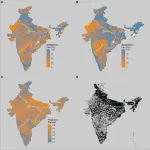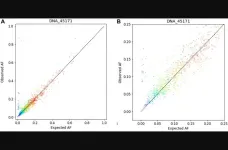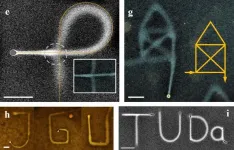(Press-News.org) MINNEAPOLIS – People who have had a stroke called an intracerebral hemorrhage who take cholesterol-lowering drugs called statins may have a lower risk of having another stroke, especially ischemic stroke, compared to people who also had an intracerebral hemorrhage but were not taking statins, according to a new study published in the August 30, 2023, online issue of Neurology®, the medical journal of the American Academy of Neurology.
Intracerebral hemorrhage is caused by bleeding in the brain. Ischemic stroke is caused by a blockage of blood flow to the brain and is the most common type of stroke.
“Previous research has had mixed results on the risk of stroke in people who are taking statins and have already had a bleeding stroke, so we evaluated this further,” said study author David Gaist, MD, PhD, of the University of Southern Denmark in Odense and a member of the American Academy of Neurology. “We looked at whether use of statins after a bleeding stroke is associated with the risk of any additional stroke, including both those caused by bleeding and by blood clots. We found that those who used statins had a lower risk of stroke, notably ischemic stroke, while there was no change in the risk of bleeding stroke.”
For the study, researchers looked at health records in Denmark and identified 15,151 people who had a first bleeding stroke.
People were followed from 30 days after their first bleeding stroke until the first occurrence of another stroke, death, or the end of follow-up, which on average lasted 3.3 years. Researchers used prescription data to determine information on statin use.
Researchers then compared 1,959 people who had another stroke to 7,400 people who did not have another stroke who were similar in age, sex and other factors. Of those who had another stroke, 757 people, or 39%, took statins compared to 3,044 people, or 41%, of those who did not have a second stroke.
After adjusting for factors like high blood pressure, diabetes and alcohol use, statin use was associated with a 12% lower risk of another stroke.
Then they compared 1,073 people who had an ischemic stroke to 4,035 people who did not have another stroke. Of those who had an ischemic stroke, 427 people, or 40%, took statins compared to 1687 people, or 42%, of those who did not have another stroke.
After adjusting for similar factors, statin use was associated with a 21% lower risk of an ischemic stroke after the initial bleeding stroke.
They also compared 984 people who had another bleeding stroke to 3,755 people who did not have another stroke. Of those who had a recurrent bleeding stroke, 385 people, or 39%, took statins compared to 1,532 people, or 41%, of those who did not have another stroke.
After adjustments, researchers did not find a link between statin use and recurrent bleeding stroke.
“The results of our study are good news for people taking statins who have had a bleeding stroke,” Gaist added. “While we did find a lower risk of having another stroke, it is important to note that when looking at the data more closely, that lower risk was for ischemic stroke. Still, we found no increased risk for bleeding stroke. More studies are needed to confirm our findings.”
A limitation of the study was that it only included the Danish population, which is primarily people of European ancestry, and may not be generalizable to people from other populations.
The study was supported by Novo Nordisk Foundation.
Learn more about stroke at BrainandLife.org, home of the American Academy of Neurology’s free patient and caregiver magazine focused on the intersection of neurologic disease and brain health. Follow Brain & Life® on Facebook, Twitter and Instagram.
When posting to social media channels about this research, we encourage you to use the hashtags #Neurology and #AANscience.
The American Academy of Neurology is the world’s largest association of neurologists and neuroscience professionals, with over 40,000 members. The AAN is dedicated to promoting the highest quality patient-centered neurologic care. A neurologist is a doctor with specialized training in diagnosing, treating and managing disorders of the brain and nervous system such as Alzheimer’s disease, stroke, migraine, multiple sclerosis, concussion, Parkinson’s disease and epilepsy.
For more information about the American Academy of Neurology, visit AAN.com or find us on Facebook, Twitter, Instagram, LinkedIn and YouTube.
END
A relatively small intervention could have a huge impact on a damaging condition that stalks children in the developing world. A new Stanford-led study shows that adding zinc to farmland soil can help prevent childhood stunting, a condition due to chronic undernutrition that is associated with poor brain development and long-lasting harmful consequences, such as reduced school performance and increased disease risks. The paper, published Aug. 21 in Scientific Reports is the first large-scale study to examine the association between children’s nutritional status or health outcomes and soil mineral availability in India, ...
“NeXT Dx incorporates a range of features and comprehensive genome variant detection methods that lead to improved disease management and possible enhanced clinical utility.”
BUFFALO, NY- August 30, 2023 – A new research paper was published in Oncotarget's Volume 14 on August 30, 2023, entitled, “Analytic validation of NeXT Dx™, a comprehensive genomic profiling assay.”
In this new research paper, researchers Juan-Sebastian Saldivar, Jason Harris, Erin Ayash, Manqing Hong, Prateek Tandon, Saloni Sinha, Patricia Miranda Hebron, Erin E. Houghton, ...
Blake Meyers, a principal investigator at the Donald Danforth Plant Science Center and a professor of plant sciences from the University of Missouri - Columbia, has been named the new director and Novozymes Chair in Genomics at the UC Davis Genome Center. Meyers, who studies plant RNA biology, bioinformatics and functional genomics, will step into the role on March 1.
A member of the National Academy of Sciences, Meyers succeeds the center’s founding director Richard Michelmore, a distinguished professor in the departments of Plant Sciences, Molecular and Cellular Biology, and Medical Microbiology and Immunology.
Roots ...
NASA uses the International Space Station — a football field-sized spacecraft orbiting Earth — to learn more about living and working in space. For over 20 years, the space station has provided a unique platform for investigation and research in areas like biology, technology, agriculture, and more. It serves as a home for astronauts conducting experiments, including advancing NASA’s space communications capabilities.
In 2023, NASA is sending a technology demonstration known as the Integrated LCRD Low Earth Orbit User ...
A new study by researchers from Mass General Brigham further illustrates that when it comes to risk of Alzheimer’s disease, even genetically determined forms of the disease, genetics is only one piece of the puzzle. Researchers investigated the influence of genetics and educational attainment on cognitive decline by studying data from 675 people who carry a mutation that predisposes them to early onset Alzheimer’s disease. Carriers of this mutation—known as PSEN1 E280A—have a median age of 49 for onset of dementia. The team found that among ...
LAWRENCE, KANSAS — A new virtual institute established at the University of Kansas School of Engineering will train the next generation of military and civilian leaders to better combat the growing threat of cyberattacks and protect the electromagnetic spectrum (EMS).
KU received a two-year, $1.5 million grant from the Department of Defense to establish the program, known as the Virtual Institutes for Cyber and Electromagnetic Spectrum Research and Employ, or VICEROY, Virtual Institute. The grant is overseen by the Griffiss Institute, which is a nonprofit talent ...
Writing is an age-old cultural technique. Thousands of years ago, humans were already carving signs and symbols into stone slabs. Scripts have become far more sophisticated since then but one aspect remains the same: Whether the writer is using cuneiform or a modern alphabet, a solid substrate, such as clay or paper, is required to fix the written structures in place. However, researchers at Johannes Gutenberg University Mainz (JGU), TU Darmstadt, and Wuhan University asked themselves how to write in a bulk fluid like water without fixing substrates. The concept would not be unlike the way aircraft leave three-dimensional vapor trails behind them when they ...
About one in every five people carries a version of a gene that, although largely unsung, appears to confer protection against both Alzheimer’s disease and Parkinson’s disease, Stanford Medicine investigators and their colleagues have learned. These lucky people may someday benefit all the more from a vaccine that could slow or stall the progression of these two most common neurodegenerative conditions.
An analysis of medical and genetic data from hundreds of thousands of people of diverse ancestries from several continents has revealed ...
First-time fathers seem to experience a steeper decline in relationship satisfaction in the first two years post-partum than second-time fathers, who appear to recover lost relationship satisfaction by the time their second child is 14 months old, according to a study published August 30, 2023 in the open-access journal PLOS ONE by Judith T. Mack and Lena Brunke from Technische Universität Dresden, Germany, and colleagues.
Having a strong primary relationship can help couples more successfully weather potentially-challenging transitions like the birth of a child. Most research on ...
Detailed analysis of two Late Bronze Age urn burials uncovers animal bones and jewelry amidst the cremated remains of a woman and child, and reveals insights into prehistoric funerary rites
###
Article URL: https://journals.plos.org/plosone/article?id=10.1371/journal.pone.0289140
Article Title: More than urns: A multi-method pipeline for analyzing cremation burials
Author Countries: Austria, Slovakia, Czech Republic, Belgium
Funding: This study was funded by the Austrian Science Fund (FWF) in the framework of the project ‘Unlocking the secrets ...






